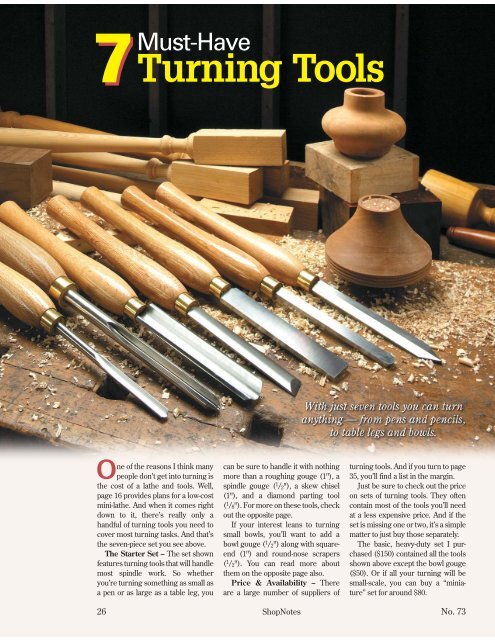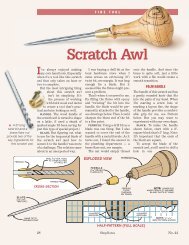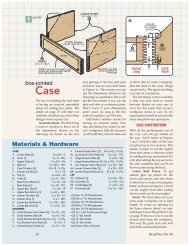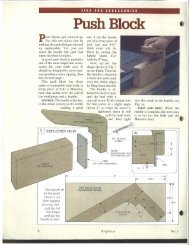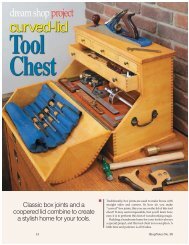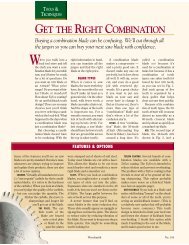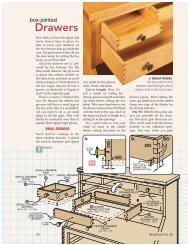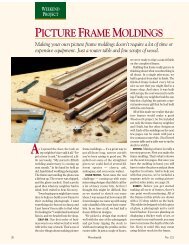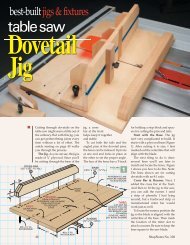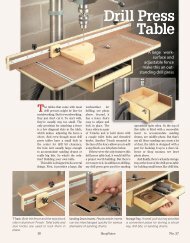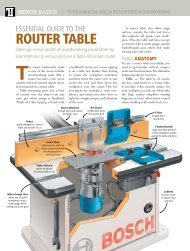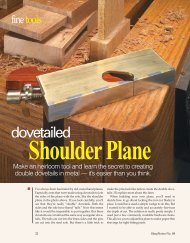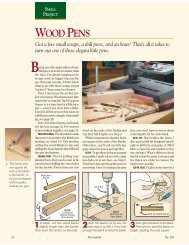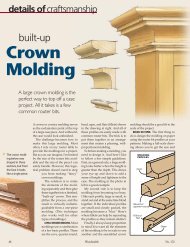ShopNotes No. 73 - Woodsmith Woodworking Seminars
ShopNotes No. 73 - Woodsmith Woodworking Seminars
ShopNotes No. 73 - Woodsmith Woodworking Seminars
Create successful ePaper yourself
Turn your PDF publications into a flip-book with our unique Google optimized e-Paper software.
7 Must-Have<br />
Turning Tools<br />
One of the reasons I think many<br />
people don’t get into turning is<br />
the cost of a lathe and tools. Well,<br />
page 16 provides plans for a low-cost<br />
mini-lathe. And when it comes right<br />
down to it, there’s really only a<br />
handful of turning tools you need to<br />
cover most turning tasks. And that’s<br />
the seven-piece set you see above.<br />
The Starter Set – The set shown<br />
features turning tools that will handle<br />
most spindle work. So whether<br />
you’re turning something as small as<br />
a pen or as large as a table leg, you<br />
can be sure to handle it with nothing<br />
more than a roughing gouge (1"), a<br />
spindle gouge ( 1 / 2"), a skew chisel<br />
(1"), and a diamond parting tool<br />
( 1 / 8"). For more on these tools, check<br />
out the opposite page.<br />
If your interest leans to turning<br />
small bowls, you’ll want to add a<br />
bowl gouge ( 1 / 2") along with squareend<br />
(1") and round-nose scrapers<br />
( 1 / 2"). You can read more about<br />
them on the opposite page also.<br />
Price & Availability – There<br />
are a large number of suppliers of<br />
turning tools. And if you turn to page<br />
35, you’ll find a list in the margin.<br />
Just be sure to check out the price<br />
on sets of turning tools. They often<br />
contain most of the tools you’ll need<br />
at a less expensive price. And if the<br />
set is missing one or two, it’s a simple<br />
matter to just buy those separately.<br />
The basic, heavy-duty set I purchased<br />
($150) contained all the tools<br />
shown above except the bowl gouge<br />
($50). Or if all your turning will be<br />
small-scale, you can buy a “miniature”<br />
set for around $80.<br />
26 <strong>Shop<strong>No</strong>tes</strong> <strong>No</strong>. <strong>73</strong>
IN THE SHOP<br />
Roughing<br />
Gouge<br />
Diamond<br />
Parting Tool<br />
Roughing Gouge —————————<br />
n One of the first tools I reach for when turning a<br />
spindle is a roughing gouge. As you can see, a roughing<br />
gouge is designed to be quite stout. This way, you can<br />
take some hefty cuts that will make quick work of<br />
“roughing” a workpiece into a cylinder (see below).<br />
Diamond Parting Tool —————<br />
n To set off parts of a turning or remove it from the<br />
lathe, I use a diamond-shaped parting tool. The shape<br />
provides better clearance and less friction when cutting<br />
deep into a workpiece. Plus, a parting tool makes quick<br />
work of cutting tenons on the ends of workpieces.<br />
Spindle<br />
Gouge<br />
Skew<br />
Chisel<br />
Spindle Gouge ——————————<br />
n A spindle gouge (see margin and drawing below) is<br />
the multi-purpose tool of turning. With it, there isn’t<br />
much you can’t do. I’ve used a spindle gouge to rough<br />
out a square blank and then shape it into a graceful table<br />
leg refined with delicate beads and coves.<br />
Skew Chisel ————————————<br />
n A skew chisel, like the oval-shaped model in the<br />
margin, is the smoothing plane of turning. Like a hand<br />
plane, it leaves behind a velvety-smooth surface that’s<br />
ready to be finished — whether you’re turning a<br />
cylinder, a graceful taper, or a set of beads.<br />
Bowl<br />
Gouge<br />
Bowl Gouge ————————————<br />
n When it comes to<br />
turning a bowl, a bowl<br />
gouge is the tool of<br />
choice. While it looks<br />
similar to a spindle<br />
gouge, it actually has a<br />
thicker, beefier body and<br />
a deeper, U-shaped flute.<br />
This design helps to<br />
quickly remove the large<br />
amount of waste necessary<br />
to create a bowl, yet<br />
produces a smooth<br />
chatter-free cut.<br />
Scrapers ———————————————<br />
n Finally, you can add a<br />
round-nose scraper and a<br />
square-end scraper to<br />
complete your set of<br />
tools (see margin).<br />
I know, scraping<br />
doesn’t sound like fine<br />
turning. But in many<br />
cases, the tiny burr that’s<br />
formed at the end of the<br />
scraper when it’s sharpened<br />
is often the only way<br />
to make a tear-out- free<br />
cut in a workpiece.<br />
Round-nose<br />
Scraper<br />
Square-end<br />
Scraper<br />
<strong>No</strong>. <strong>73</strong> <strong>Shop<strong>No</strong>tes</strong> 27


